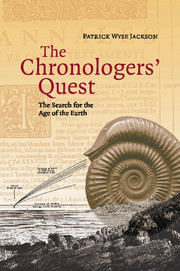Book contents
- Frontmatter
- Contents
- List of illustrations
- List of tables
- Preface
- Acknowledgements
- 1 The ancients: early chronologies
- 2 Biblical calculations
- 3 Models of Aristotelian infinity and sacred theories of the Earth
- 4 Falling stones, salty oceans, and evaporating waters: early empirical measurements of the age of the Earth
- 5 Thinking in layers: early ideas in stratigraphy
- 6 An infinite and cyclical Earth and religious orthodoxy
- 7 The cooling Earth
- 8 Stratigraphical laws, uniformitarianism and the development of the geological column
- 9 ‘Formed stones’ and their subsequent role in biostratigraphy and evolutionary theory
- 10 The hour-glass of accumulated or denuded sediments
- 11 Thermodynamics and the cooling Earth revisited
- 12 Oceanic salination reconsidered
- 13 Radioactivity: invisible geochronometers
- 14 The Universal problem and Duck Soup
- Bibliography
- Index
10 - The hour-glass of accumulated or denuded sediments
Published online by Cambridge University Press: 02 December 2009
- Frontmatter
- Contents
- List of illustrations
- List of tables
- Preface
- Acknowledgements
- 1 The ancients: early chronologies
- 2 Biblical calculations
- 3 Models of Aristotelian infinity and sacred theories of the Earth
- 4 Falling stones, salty oceans, and evaporating waters: early empirical measurements of the age of the Earth
- 5 Thinking in layers: early ideas in stratigraphy
- 6 An infinite and cyclical Earth and religious orthodoxy
- 7 The cooling Earth
- 8 Stratigraphical laws, uniformitarianism and the development of the geological column
- 9 ‘Formed stones’ and their subsequent role in biostratigraphy and evolutionary theory
- 10 The hour-glass of accumulated or denuded sediments
- 11 Thermodynamics and the cooling Earth revisited
- 12 Oceanic salination reconsidered
- 13 Radioactivity: invisible geochronometers
- 14 The Universal problem and Duck Soup
- Bibliography
- Index
Summary
In July 1798 Napoleon Bonaparte's army invaded Egypt and commenced a huge and famous survey of its antiquities and natural history. The French hold on the region was weakened following the celebrated Battle of the Nile when Horatio Nelson (1758–1805) showed his prowess, and the British assumed control in 1801. Thereafter the fashion for things Egyptian spread to England and remained much in vogue until the 1920s. There is a nineteenth-century children's ditty that describes the foolish woman who, grinning to her worried friends, set off to explore the River Nile riding on the back of a crocodile: ‘at the end of the ride the lady was inside and the smile was on the crocodile.’ An earlier traveller was more fortunate, and he lived to make one of the earliest contributions to geological literature.
Herodotus (484–408 bc) was a Greek traveller born in Western Anatolia (what is now Turkey) who has been styled the ‘Father of Geography’ on account of his writings and observations on the changes effected on the Earth's surface by river action and erosion. Although Herodotus did not travel widely by modern standards (his world was a triangle drawn between Greece, Italy and Egypt), by standards in the fifth century bc he would have clocked up plenty of ‘mileage points’. On one trip he sailed to Egypt and onwards up the Nile, preferring to use a boat unlike the crocodile-riding lady, and the first thing that struck him as he approached Egypt was that the sea was very shallow far out to sea, and that it continued to shallow as he approached the delta front a day's sailing away.
- Type
- Chapter
- Information
- The Chronologers' QuestThe Search for the Age of the Earth, pp. 171 - 196Publisher: Cambridge University PressPrint publication year: 2006



